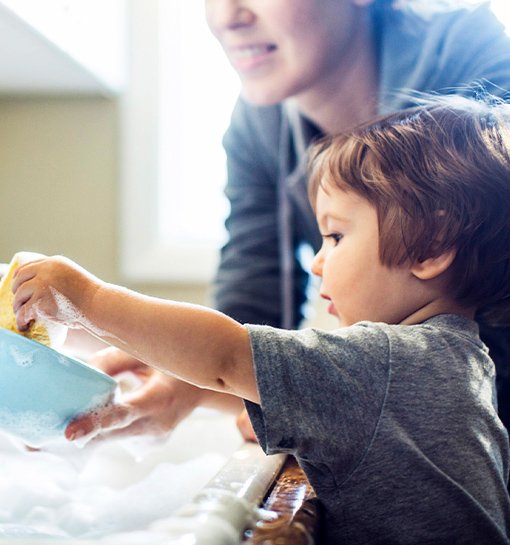How to make natural dyed dumplings
12 June 2020

Norland students are always looking at ways they can make learning interactive for children, and that’s no different in Food and Nutrition. Ike (Set 43) has shared his recipe for vibrant Chinese dumplings that children will absolutely love getting involved with, as well as eating!
Chinese dumplings have always been a favourite of mine. Some of my favourite childhood cooking memories were sitting around the table with my family wrapping these delicious dumplings. To me, cooking is all about creating fun experiences with no limits. There’s no wrong or right way to wrap these dumplings as long as it holds your tasty fillings.
You can also experiment with your fillings. Do you pack them with protein? How about making them completely vegetarian? Or could you have a mix? The options are endless with dumplings. What I love the most is once it’s all cooked, these are the type of food that you can put in the middle of the table and will disappear within minutes.

“With this recipe, children can engage their senses. Feeling the soft dough, smelling the different ingredients, looking at how the food naturally changes the colour of the dough, listening to the crackling noises when you’re frying them and tasting the end product!”
Recipe
Green dough
- 120g of spinach
- 1 cup of flour
Purple dough
- 3 whole cooked and peeled beetroots
- 1 cup of flour
Yellow dough
- 2 tbsp of turmeric powder
- ⅓ cup of hot water
- 1 cup of flour
Orange dough
- 1 large carrot
- 1 cup of flour
The filling – dry ingredients
- 3 spring onions
- ¼ white cabbage
- ½ a large carrot
- 3 cloves of garlic
- 1 baby lettuce
- 60g of ginger
- 150g mushrooms
- Handful of parsley
- 200g pork mince
- 150g prawns
This filling will be just as delicious without the meat and fish if you’re vegetarian.
The filling – wet ingredients
- 3 tbsp soy sauce
- 2 tbsp sweet chilli sauce (optional)
- 2 tbsp sesame oil
- 1 tbsp tamarind paste (optional)
- 2 tbsp Worcester sauce
- 1 tbsp of fish sauce

Method
Green dough
Add the spinach into boiling water for 5 minutes. Then strain the spinach and pop into a blender.
Blend the spinach until it’s a runny liquid and pass it through a sieve making sure you have a bowl underneath to collect all of the liquid.
Combine the liquid spinach into a bowl with the flour and knead for around 5 minutes until you have a soft and smooth dough.
Cover your dough in cling film and set aside to rest.
Purple dough
I bought whole peeled and cooked vacuum sealed beetroots. This meant that half the job was already done.
Yellow dough
For the yellow dough use the same cup that you are using to measure the flour and add ⅓ of boiling water.
Then stir in the turmeric powder and add into a bowl with the flour.
Combine the two ingredients and knead for around 5 minutes until soft and smooth.
Wrap the dough in cling film and leave to rest.
Simply blend the beetroots and pass it through a sieve catching all of the liquid underneath. Place the liquid into a bowl and combine it with the flour.
Knead the dough for around 5 minutes until it’s soft and smooth.
Wrap it in cling film and set aside to rest.
Orange dough
Chop the carrot into cubes and boil until they are soft. Then strain the water and put the cooked carrot into a blender.
Blend the carrot until all solids have gone. Next pass the carrot through a sieve with a bowl underneath to catch the liquid. Then add the liquid into a bowl of flour and combine.
Knead the dough for 5 minutes until it’s soft and smooth.
Wrap the dough in cling film and set aside to rest.
All of the doughs need to rest for a minimum of 45 minutes. You can also store them in a fridge but make sure you take them out 1 hour and a half before using it.
The filling
To create this delicious filling, finely chop all the ingredients apart from the carrot which I always love to grate.
Then add in the wet ingredients and combine well.
The great part about this recipe is that you can experiment with what filling you want to use. I created this filling with what I had in my fridge. It is also a great way to combine lots of healthy vegetables.
Creating your dumplings
After you have let your dough set, flour your surface, and mould your dough into a doughnut shape making sure all sides are equal.
Then cut your doughnut so you are left with a long equally sized tube.
Next cut your tube into equal pieces and place under a towel to keep them from going dry.
For the classic dumpling shape take one of your pieces of dough from under your towel and roll it into a ball.
Use the palm of your hand to squash it as hard as you can, making sure you try to keep a circle shape.
Then using your left hand to rotate the dough and your right hand using the rolling pin you want to work your way around your circle rolling out the edges. It’s important to not roll the dough from the centre as you want the edges of your circle to be thinner to help your dumpling seal together. You want your wrapper to be around the size of an adult hand or 6-7cm in width.
Place your circle in your hand and place around a teaspoon of filling in the centre. Make sure you don’t add too much, or you won’t be able to seal your dumpling well.
To seal the dumpling bring the bottom of the wrapper to the top to create a semi-circle. Pinch your dough together at the edges and pleat all the way along. It’s important you don’t leave any gaps and you’ve sealed it well.
Cover your finished dumpling under a towel to stop them from going dry.
Cooking your dumplings
There are many ways to cook your dumplings. Personally, I love to shallow fry them because it gives them a lovely golden finish to them, leaving you with a pleasant crunch.
Most importantly, make sure you have a dipping sauce. This could be soy sauce, or in most Asian supermarkets you can buy a classic ‘dumpling sauce’.

How can children get involved?
The best thing about this recipe is that it’s so fun when you have the whole family getting stuck in. Children can help pass the ingredients through the sieve and look at the vibrant colours coming out into the bowl. Let children press the blend button and watch the solids turn into liquids. They can also get their hands messy by kneading the colourful dough. With supervision, let children practise their fine motor skills by chopping the vegetables. When you are weighing out any ingredients count out loud to introduce meanings to numbers. Lastly, allow children to have a go at wrapping the dumplings.
If you like this recipe I have lots of recipes on my Instagram account where I also have a demonstration video on how to wrap these delicious dumplings. There are also lots of fun ways to wrap dumplings on YouTube.








